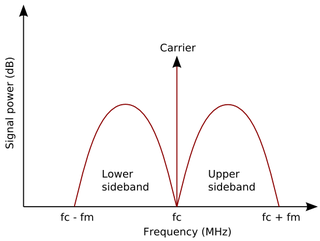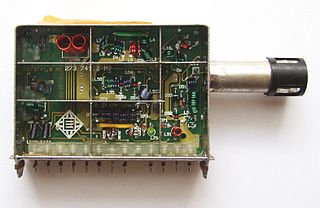
In radio communications, a sideband is a band of frequencies higher than or lower than the carrier frequency, that are the result of the modulation process. The sidebands carry the information transmitted by the radio signal. The sidebands comprise all the spectral components of the modulated signal except the carrier. The signal components above the carrier frequency constitute the upper sideband (USB), and those below the carrier frequency constitute the lower sideband (LSB). All forms of modulation produce sidebands.

Digital audio broadcasting (DAB) is a digital radio standard for broadcasting digital audio radio services in many countries around the world but not in North America where HD Radio is the standard for digital radio.

Medium wave (MW) is the part of the medium frequency (MF) radio band used mainly for AM radio broadcasting. The spectrum provides about 120 channels with limited sound quality. During daytime, only local stations can be received. Propagation in the night allows strong signals within a range of about 2,000 km. This can cause massive interference because on most channels, about 20 to 50 transmitters operate simultaneously worldwide. In addition to that, amplitude modulation (AM) is prone to interference by all sorts of electronic devices, especially power supplies and computers. Strong transmitters cover larger areas than on the FM broadcast band but require more energy. Digital modes are possible but have not reached the momentum yet.

AM broadcasting is radio broadcasting using amplitude modulation (AM) transmissions. It was the first method developed for making audio radio transmissions, and is still used worldwide, primarily for medium wave transmissions, but also on the longwave and shortwave radio bands.

Radio broadcasting is transmission of audio (sound), sometimes with related metadata, by radio waves intended to reach a wide audience. In terrestrial radio broadcasting the radio waves are broadcast by a land-based radio station, while in satellite radio the radio waves are broadcast by a satellite in Earth orbit. To receive the content the listener must have a broadcast radio receiver (radio). Stations are often affiliated with a radio network which provides content in a common radio format, either in broadcast syndication or simulcast or both. Radio stations broadcast with several different types of modulation: AM radio stations transmit in AM, FM radio stations transmit in FM, which are older analog audio standards, while newer digital radio stations transmit in several digital audio standards: DAB, HD radio, DRM. Television broadcasting is a separate service which also uses radio frequencies to broadcast television (video) signals.
In-band on-channel (IBOC) is a hybrid method of transmitting digital radio and analog radio broadcast signals simultaneously on the same frequency.
A subcarrier is a sideband of a radio frequency carrier wave, which is modulated to send additional information. Examples include the provision of colour in a black and white television system or the provision of stereo in a monophonic radio broadcast. There is no physical difference between a carrier and a subcarrier; the "sub" implies that it has been derived from a carrier, which has been amplitude modulated by a steady signal and has a constant frequency relation to it.
The FM broadcast band is a range of radio frequencies used for FM broadcasting by radio stations. The range of frequencies used differs between different parts of the world. In Europe and Africa and in Australia, it spans from 87.5 to 108 megahertz (MHz) - also known as VHF Band II - while in the Americas it ranges from 88 to 108 MHz. The FM broadcast band in Japan uses 76 to 95 MHz. The International Radio and Television Organisation (OIRT) band in Eastern Europe is from 65.8 to 74.0 MHz, although these countries now primarily use the 87.5 to 108 MHz band, as in the case of Russia. Some other countries have already discontinued the OIRT band and have changed to the 87.5 to 108 MHz band.
C-QUAM is the method of AM stereo broadcasting used in Canada, the United States and most other countries. It was invented in 1977 by Norman Parker, Francis Hilbert, and Yoshio Sakaie, and published in an IEEE journal.

Digital Radio Mondiale is a set of digital audio broadcasting technologies designed to work over the bands currently used for analogue radio broadcasting including AM broadcasting, particularly shortwave, and FM broadcasting. DRM is more spectrally efficient than AM and FM, allowing more stations, at higher quality, into a given amount of bandwidth, using xHE-AAC audio coding format. Various other MPEG-4 and Opus codecs are also compatible, but the standard now specifies xHE-AAC.
Digital radio is the use of digital technology to transmit or receive across the radio spectrum. Digital transmission by radio waves includes digital broadcasting, and especially digital audio radio services.
Multichannel Television Sound, better known as MTS, is the method of encoding three additional audio channels into an analog NTSC-format audio carrier. It was developed by the Broadcast Television Systems Committee, an industry group, and sometimes known as BTSC as a result.
AM stereo is a term given to a series of mutually incompatible techniques for radio broadcasting stereo audio in the AM band in a manner that is compatible with standard AM receivers. There are two main classes of systems: independent sideband (ISB) systems, promoted principally by American broadcast engineer Leonard R. Kahn; and quadrature amplitude modulation (QAM) multiplexing systems.

A tuner is a subsystem that receives radio frequency (RF) transmissions and converts the selected carrier frequency and its associated bandwidth into a fixed frequency that is suitable for further processing, usually because a lower frequency is used on the output. Broadcast FM/AM transmissions usually feed this intermediate frequency (IF) directly into a demodulator that converts the radio signal into audio-frequency signals that can be fed into an amplifier to drive a loudspeaker.

HD Radio (HDR) is a trademarked term for the in-band on-channel (IBOC) digital radio technology used by AM and FM radio stations mostly in the United States, Canada and Mexico, with a few implementations outside North America. The system transmits additional digital data associated with an existing radio station's standard analog signals, rebroadcasting the same signal in a digital format with less noise. The digital data may also include up to three additional digital radio signals, which can be used to broadcast other stations within the same frequency allocation.

FM broadcasting is a method of radio broadcasting using frequency modulation (FM). Invented in 1933 by American engineer Edwin Armstrong, wide-band FM is used worldwide to provide high fidelity sound over broadcast radio. FM broadcasting is capable of higher fidelity—that is, more accurate reproduction of the original program sound—than other broadcasting technologies, such as AM broadcasting. Therefore, FM is used for most broadcasts of music or general audio. FM radio stations use the very high frequency range of radio frequencies.
Subsidiary Communications Authorization (SCA) in the United States, and Subsidiary Communications Multiplex Operation (SCMO) in Canada, is a subcarrier on a radio station, allowing the station to broadcast additional services as part of its signal.
The National Radio Systems Committee (NRSC) is an organization sponsored by the Consumer Technology Association (CTA) and the National Association of Broadcasters (NAB). Its main purpose is to set industry technical standards for radio broadcasting in the United States. While regulatory authority rests with the FCC, it usually adopts NRSC recommendations, such as RBDS and spectral masks. For U.S. television, the NTSC sets standards.
Apex radio stations was the name commonly given to a short-lived group of United States broadcasting stations, which were used to evaluate transmitting on frequencies that were much higher than the ones used by standard amplitude modulation (AM) and shortwave stations. Their name came from the tall height of their transmitter antennas, which were needed because coverage was primarily limited to local line-of-sight distances. These stations were assigned to what at the time were described as "ultra-high shortwave" frequencies, between roughly 25 and 44 MHz. They employed amplitude modulation (AM) transmissions, although in most cases using a wider bandwidth than standard broadcast band AM stations, in order to provide high fidelity sound with less static and distortion.

Radio is the technology of signaling and communicating using radio waves. Radio waves are electromagnetic waves of frequency between 30 hertz (Hz) and 300 gigahertz (GHz). They are generated by an electronic device called a transmitter connected to an antenna which radiates the waves, and received by another antenna connected to a radio receiver. Radio is very widely used in modern technology, in radio communication, radar, radio navigation, remote control, remote sensing and other applications.









